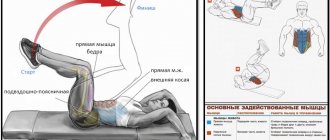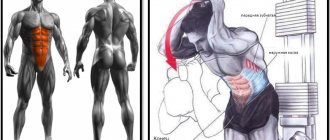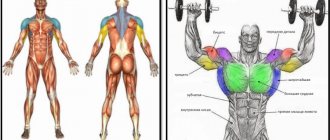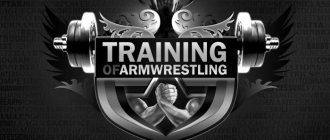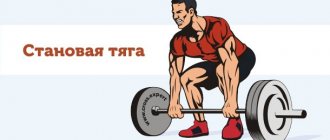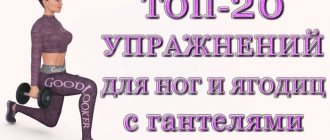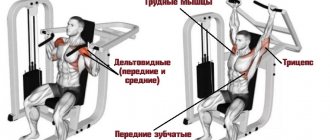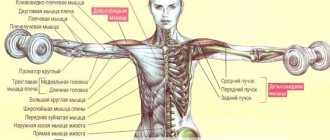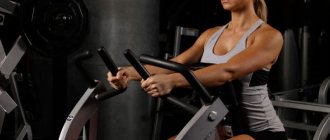The word crunch is translated as crunch, crackle and similar. However, when it comes to exercise, it refers to twisting or bending of the body.
Perhaps twisting is the most accurate word here, as it defines the main aspects of this movement. Crunches are performed with an emphasis on twisting in whatever planes the movement is made.
Even if you just lift the body, it seems to be twisted like a rug towards the opposite side.
Benefits of crunches
This element is used in both women's and men's fitness programs. Its popularity is due to its beneficial properties:
- High-quality press work. There are many variations of crunches. If you correctly combine several similar exercises in a program, the abdominal muscles will receive a complex load, which will increase the effectiveness of the training.
- Improved spine flexibility. Twisting has a positive effect on the extensibility of the vertebrae, improves overall back mobility, and relieves pain associated with muscle strain.
- Universal application. Many exercise options do not require the purchase of additional sports equipment, so crunches can be done not only in the gym, but also at home.
- Figure correction. Twisting from different positions indirectly affects other muscle groups. For example, when performing an exercise with your back resting on a fitness ball, your hips and buttocks are additionally loaded, holding the pelvis suspended. Due to this, there is an increased consumption of calories and, as a result, weight loss.
Advice for newbies! There is no need to train your abs on a separate day. The abdominal muscles are involved in most exercises: deadlifts, presses, squats and others. Therefore, it is better to add 2 different variations of crunches at the end of each lesson. This way you will avoid overtraining your abs and give this muscle group a good workout.
The exercises in question can be used for various purposes:
- to work out the relief (example: high-speed crunches on the floor);
- to increase the strength of the abdominal muscles (example: crunches in a block machine).
Useful tips
While performing crunches:
- Don't get carried away with too many repetitions. The optimal number is 60 times in three or more sets. Remember, the main thing is quality, not quantity.
- It is important to select the correct frequency of the training itself, that is, it is imperative to give the muscles the opportunity to recover and rest for at least one or two days.
- Keep your speed under control. Don't go too slow or too fast. It all depends on the type of twist; the best option would be to combine tempos.
Correct technique
The most popular is the classic variation of the exercise. Let's look at the technique:
- To perform this you will need a flat, hard surface. Do not do crunches on a soft mattress or bed. If you find it hard to lie on a bare floor, lay down a fitness mat.
- Lie on your back and touch your ears with your fingertips. Fix your hands at your head.
- Press your lower back firmly into the mat.
- Bend your legs and place your feet on the floor. The distance between the knees is at the level of the pelvis.
- Exhale and, by contracting your abdominal muscles, lift your shoulder blades off the floor. Do not press your chin to your chest.
- Inhale and move the shoulder girdle back, but do not lower your shoulder blades to the floor at the lowest point. Keep them suspended at all times. This will increase tension in the rectus muscle.
As you perform, keep your lower back pressed to the floor. Only the upper torso rises. In this case, adjust the lifting height yourself.
Advice for newbies! Do you want to quickly get rid of subcutaneous fat at the waist and see the treasured “cubes”? Buy a weighted hoop with massage spikes and spin it for 10-15 minutes at the end of each workout.
Other exercise variations
The abs are a group of muscles. Therefore, for effective training, various loads are required. We offer the most effective twisting options.
Reverse
- Lower your back to the floor. Stretch your arms along your body. Palms face down.
- Bring your feet together and lift your hips vertically. Bend your knee joints at a right angle. Fix your legs in this suspended position.
- With your palms on the floor, exhale and lift your pelvis, pulling your knees toward your chest.
- As you inhale, lower your lower back to the floor.
Lifting the legs should be done by contracting the abs, not tensing the quadriceps.
Lateral
- Press your back to the floor. Bring your legs together and bend them. Move your knees to the right and press them to the floor. The angle between the hips and the body should be straight. The angle at the knees must also be kept at 90°.
- Press your right palm onto your knees, and press your left palm to the back of your head. Lower your shoulder blades to the floor.
- Exhale and twist your upper torso to the right, extending your left elbow at an upward angle.
- As you inhale, lower yourself to the starting position.
The exercise is performed in both directions. When twisting, press firmly with your free hand on the knee joints, this will create additional stretch in the oblique muscles.
With your feet up
- Lie down on the floor and press your lower back. Clasp your fingers at the back of your head.
- Close your feet and lift your legs vertically. The angle between the thigh and body should be straight. For comfort, you can slightly bend your knees.
- Keeping your legs still, exhale and lift your upper torso. Lift by contracting the abdominal muscles.
- As you inhale, move your shoulder blades down, but do not lower them to the floor.
If you want to make the exercise more difficult, change the angle of your legs from 90° to 70–80°.
Diagonal
- Lie on your back and press your lower back into the floor. Place your palms on the back of your head, clasping your fingers.
- Raise your legs above the floor.
- Exhale powerfully and twist your shoulder girdle to the right. At the same time, pull your right knee towards you.
- Repeat twisting to the left.
Keep your abdominal muscles tense throughout the entire approach.
Double
- Lie on your back, clasp your palms at the back of your head.
- Raise your legs vertically and bend your knees at an angle of 90°.
- Exhale while simultaneously pulling your hips toward you and lifting your shoulder blades.
- Inhale and return to the starting position, but do not place your shoulder blades on the floor.
When your face and knees are close to each other, tighten your abdominal muscles as much as possible.
On an incline bench
The bench is used to create an incline and increase the load. As a rule, crunches on a bench are performed using classical and reverse techniques (described above). The only difference is that you should firmly grasp the edge of the seat with your hands to maintain balance.
Choose the angle of inclination yourself. For beginners, we recommend starting with an angle of 15–20°. All other biomechanics of movements are identical to standard crunches on the floor.
On a Roman chair
A special chair is used that fixes the legs in a stationary position. The upper body is suspended. From this position, the athlete curls his upper torso toward his knees and tightens his abdominal muscles.
The position of the arms is any: behind the head, extended forward, crossed on the chest. To increase the load, you can use additional weight (a barbell, dumbbell or other weight) held against the pectoral muscles or behind the neck.
Kneeling in a pulley machine
- Hook the rope handle to the top cable.
- Turn your back to the block, take a short step forward and drop to your knees.
- Press the ends of the handle against the trapezius muscle of the back.
- Exhale and gently twist your upper body toward your knees.
- As you inhale, gently raise your shoulder girdle.
When performing, do not allow jerky movements.
Standing in a pulley machine
- Attach a rope handle to the lower cable, pull it up and turn your back to the block.
- Straighten up and place your feet shoulder-width apart.
- Throw the ends of the handle over your shoulder.
- Exhale and twist your torso towards the opposite leg.
- As you inhale, straighten up.
Twist your entire torso to the side, not just your shoulder girdle.
On a fitness ball
- Press your upper back into the ball. Place your feet firmly on the floor and lift your pelvis.
- Spread your knees shoulder-width apart, clasp your palms behind your head.
- Keeping your pelvic region motionless and suspended, perform forward twists. Do not lower your shoulder blades onto the fitball at the lowest point.
The exercise is also suitable for working the oblique muscles. To do this, twist the shoulder girdle to the sides.
Russians
- Sit on the floor, on your buttocks. Bend your legs and lock your feet in one position, placing them under a stable object.
- Lean your body back slightly, creating a V-shaped body position.
- Stretch your arms forward and clasp your hands.
- Keeping your back tilted, exhale and turn your body to the right. Repeat on both sides.
Avoid rounding your back when performing.
In the “hanging on your forearms” position
To perform this, a special simulator is used, which has a soft back and hand rests, and allows you to hang on your forearms.
The athlete rests his elbows on soft pillows, firmly clasps the handles with his palms and performs a hang. The spine is pressed tightly against the back of the machine. From this position, the athlete simultaneously pulls his knees to his chest.
Lateral hyperextensions
To perform this, a hyperextension machine is used. The athlete stands sideways in the exercise machine. In this case, the femur rests against the edge of the inclined back, and the legs stand firmly on the platforms. Hands go behind your head. From this position, the athlete performs smooth sideways bends.
To increase the load, it is allowed to use additional weight (barbell plate, small bar, body bar) held on the chest or shoulders.
Advice for newbies! If you want to maximize the use of muscle fibers and enhance the effect of any abdominal exercise, at the extreme point of twisting, strongly tighten your abdominal muscles and hold for 2-3 seconds.
How to do crunches: the simplest and most effective exercise for toned abs
The word crunch is translated as crunch, crackle and similar. However, when it comes to exercise, it refers to twisting or bending of the body.
Perhaps twisting is the most accurate word here, as it defines the main aspects of this movement. Crunches are performed with an emphasis on twisting in whatever planes the movement is made.
Even if you just lift the body, it seems to be twisted like a rug towards the opposite side.
What's the benefit?
Any physical activity, to one degree or another, brings only benefits to the body. They improve the condition of the figure, increase strength and endurance. What role does the exercise called twisting or crunch play in this? What it is? To what group of exercises can they be classified? Crunches are designed to increase mobility and flexibility of the spine. Research shows that regular crunches help reduce pain in this area. Crunches are considered strength training. These abdominal exercises develop flexibility and make joints more mobile.
Classic crunches
Let's start with the classic version.
It is performed as follows:
- lie completely on your back;
- press your lower back to the surface;
- hands behind your head or above your chest;
- lifting only the upper body, tearing off the shoulder blades;
- Having reached the thoracic spine in a twisting movement, you return back.
Note. Options may vary. With your legs bent at 90 degrees, or with your legs straight. If you work correctly, only with the upper body, then the difference in these options is insignificant
While performing crunches, you can imagine that you are curling yourself onto a certain roller that lies on the front surface of your body, somewhere in the chest area.
The movement begins with the raising of the head, then the neck remains relatively straight, but the spine, with the separation of the shoulder blades, begins to twist and forms a kind of stoop. When you reach the limit of movement, with your lower back fully pressed, you return back.
Substitutions
Fans believe that imitating a crease will not work. But in practice, there are several exercises that use muscles in the same way:
- Simultaneous twisting “knees to elbows” while lying down. Yes, the amplitude here is shorter, and the athlete does not use the rectus muscle as actively, but the exercise can be done by everyone;
- Standing "rocket" or arm-to-leg pulls, especially when arms are extended overhead with weights
- A movement in an ab machine that allows you to both bring your legs towards your waist and bring your upper body towards your legs. This version of the exercise allows you to load the muscles more than in the fold, since the machine is designed for additional resistance.
Anyway, the fold is a very popular movement, and it’s definitely worth learning how to do it.
How to pump up your abs - belly - No. 339. Fold lying on your back on the floor - lose weight in your abs!
Watch this video on YouTube
Reverse crunches
In addition, there is a variant of reverse crunches, which allow you to pump your lower abdomen. The process is almost identical, only you need to do something similar with the lower body.
Thus, here the shoulder blades and thoracic spine (as well as the head) are pressed to the floor, but here:
They rise from the floor. You should perform the same twisting movement, only now you seem to wrap the abdominal area from the pubis to the sternum on a roller. The hips are not thrown far towards the head, the emphasis of the movement is mainly on working the lower abdomen and core muscles.
Abdominal training muscle atlas
Another name for abdominal crunches is abdominal crunches. The training is aimed at the rectus abdominis muscle, which is responsible for the appearance of six-pack abs - the dream of everyone who wants to replace “one big ball” with them. Training - abdominal crunches help strengthen the abdominal muscle corset completely, making the core muscles stronger.
In addition to them, the following press participants take part in the training:
- pectoral;
- internal and external obliques;
- transverse abdominals.
The picture below demonstrates this:
The essence of abdominal crunches is to round the spine, which brings the pelvis and chest closer together. During crunches, the lower and middle parts of the back remain pressed to the floor. The hip and spine flexors work to a minimum, and the isolated load is directed to the abdominal muscles. Now in more detail about each muscle that is involved in twisting.
Straight
Long and thin, it runs from the middle of the chest to the pubic area. There is an opinion that these are two muscles, divided into lower and upper cubes. There is actually only one, and is used when the spinal column bends forward, causing the chest and pelvis to meet. This muscle is the main one. She participates in abdominal crunches.
Oblique (external and internal)
In order to become the owner of a narrow waist, you need to train the oblique abdominal muscles, adding body turns to the main movement. When an athlete trains the internal oblique muscle, the external oblique is automatically connected on the opposite side of the waist.
Transverse abdominal muscles
This muscle has fibers scattered throughout the lower abdomen. It is easy to feel when inhaling and exhaling deeply. It helps in the implementation of forced exhalation and keeping the lower abdominal area flat during various twisting trainings.
Common mistakes
Let's look at the most common misconceptions. Many believe that the principle “the more repetitions, the better” works here. In fact, the effect comes from powerful muscle tension combined with concentration. And with this approach it is difficult to go beyond 15-25 repetitions. If it turns out more, then something is wrong.
To work out your abs, 2-3 workouts a week are enough. In the future, when the body gets stronger and the abs are a priority, you can perform a set of exercises more often. But at first there is no point in loading the muscles more intensely - they also need recovery.
Six packs will not appear if the diet is not followed in parallel with training. Ignoring diet will require a lot of repetition to be effective. And this is impossible. The same applies to the use of weights. Many people think that if the cubes don’t appear, it means they need to pick up a barbell. This is a mistake - without an integrated approach, you won’t see cubes, even with pancakes, even without them. The more important thing is not chasing the scale, but mental concentration and less fat consumption.
What it is?
Crunches for the press are called twisting, that is, reducing the distance between the chest and pelvis by flexing the spine. Thanks to these actions, the abdominal area and oblique muscles are worked out. Regular exercise will allow you to get those coveted six-pack abs over time.
The main effect of crunches is due to strong contractions of the abdominal muscles. Thanks to the dynamic and regular execution of the exercise, a powerful metabolic press is created, which stimulates the hypertrophy of certain areas. So, gradually the relief is outlined and becomes more pronounced.
Additionally, it is worth noting that crunches promote blood flow to the deep muscle layers, fascia and the spine itself, which helps speed up the transport of nutrients that help maintain their youth and health.
Crunch recipe. Calorie, chemical composition and nutritional value.
Nutritional value and chemical composition of “Crunch”.
The table shows the nutritional content (calories, proteins, fats, carbohydrates, vitamins and minerals) per 100 grams of edible portion.
| Nutrient | Quantity | Norm** | % of the norm in 100 g | % of the norm in 100 kcal | 100% normal |
| Calorie content | 355 kcal | 1684 kcal | 21.1% | 5.9% | 474 g |
| Squirrels | 9.5 g | 76 g | 12.5% | 3.5% | 800 g |
| Fats | 16.5 g | 56 g | 29.5% | 8.3% | 339 g |
| Carbohydrates | 42.5 g | 219 g | 19.4% | 5.5% | 515 g |
| Organic acids | 0.1 g | ~ | |||
| Alimentary fiber | 5.9 g | 20 g | 29.5% | 8.3% | 339 g |
| Water | 23.6 g | 2273 g | 1% | 0.3% | 9631 g |
| Ash | 1.88 g | ~ | |||
| Vitamins | |||||
| Vitamin A, RE | 3.9 mcg | 900 mcg | 0.4% | 0.1% | 23077 g |
| alpha carotene | 0.006 mcg | ~ | |||
| beta carotene | 0.039 mg | 5 mg | 0.8% | 0.2% | 12821 g |
| beta Cryptoxanthin | 1.263 mcg | ~ | |||
| Lycopene | 0.092 mcg | ~ | |||
| Lutein + Zeaxanthin | 10.508 mcg | ~ | |||
| Vitamin B1, thiamine | 0.647 mg | 1.5 mg | 43.1% | 12.1% | 232 g |
| Vitamin B2, riboflavin | 0.097 mg | 1.8 mg | 5.4% | 1.5% | 1856 |
| Vitamin B4, choline | 29.59 mg | 500 mg | 5.9% | 1.7% | 1690 g |
| Vitamin B5, pantothenic | 0.868 mg | 5 mg | 17.4% | 4.9% | 576 g |
| Vitamin B6, pyridoxine | 0.528 mg | 2 mg | 26.4% | 7.4% | 379 g |
| Vitamin B9, folates | 76.876 mcg | 400 mcg | 19.2% | 5.4% | 520 g |
| Vitamin C, ascorbic acid | 5.05 mg | 90 mg | 5.6% | 1.6% | 1782 g |
| Vitamin E, alpha tocopherol, TE | 9.275 mg | 15 mg | 61.8% | 17.4% | 162 g |
| gamma tocopherol | 0.064 mg | ~ | |||
| delta tocopherol | 0.002 mg | ~ | |||
| Vitamin H, biotin | 194.34 mcg | 50 mcg | 388.7% | 109.5% | 26 g |
| Vitamin K, phylloquinone | 1.6 mcg | 120 mcg | 1.3% | 0.4% | 7500 g |
| Vitamin RR, NE | 6.1061 mg | 20 mg | 30.5% | 8.6% | 328 g |
| Niacin | 3.126 mg | ~ | |||
| Betaine | 0.152 mg | ~ | |||
| Macronutrients | |||||
| Potassium, K | 519.5 mg | 2500 mg | 20.8% | 5.9% | 481 g |
| Calcium, Ca | 147.44 mg | 1000 mg | 14.7% | 4.1% | 678 g |
| Silicon, Si | 2.264 mg | 30 mg | 7.5% | 2.1% | 1325 g |
| Magnesium, Mg | 139.6 mg | 400 mg | 34.9% | 9.8% | 287 g |
| Sodium, Na | 50.92 mg | 1300 mg | 3.9% | 1.1% | 2553 g |
| Sera, S | 86.36 mg | 1000 mg | 8.6% | 2.4% | 1158 g |
| Phosphorus, Ph | 251.3 mg | 800 mg | 31.4% | 8.8% | 318 g |
| Chlorine, Cl | 30.52 mg | 2300 mg | 1.3% | 0.4% | 7536 g |
| Microelements | |||||
| Aluminium, Al | 83.8 mcg | ~ | |||
| Bor, B | 32.1 mcg | ~ | |||
| Vanadium, V | 23.8 mcg | ~ | |||
| Iron, Fe | 3.137 mg | 18 mg | 17.4% | 4.9% | 574 g |
| Yod, I | 3.34 mcg | 150 mcg | 2.2% | 0.6% | 4491 g |
| Cobalt, Co | 2.679 mcg | 10 mcg | 26.8% | 7.5% | 373 g |
| Lithium, Li | 2.009 mcg | ~ | |||
| Manganese, Mn | 1.6595 mg | 2 mg | 83% | 23.4% | 121 g |
| Copper, Cu | 742.4 mcg | 1000 mcg | 74.2% | 20.9% | 135 g |
| Molybdenum, Mo | 5.519 mcg | 70 mcg | 7.9% | 2.2% | 1268 g |
| Nickel, Ni | 40.755 mcg | ~ | |||
| Rubidium, Rb | 7.4 mcg | ~ | |||
| Selenium, Se | 21.893 mcg | 55 mcg | 39.8% | 11.2% | 251 g |
| Strontium, Sr | 7.7 mcg | ~ | |||
| Titanium, Ti | 7.9 mcg | ~ | |||
| Fluorine, F | 36.37 mcg | 4000 mcg | 0.9% | 0.3% | 10998 g |
| Chromium, Cr | 0.37 mcg | 50 mcg | 0.7% | 0.2% | 13514 g |
| Zinc, Zn | 2.3116 mg | 12 mg | 19.3% | 5.4% | 519 g |
| Zirconium, Zr | 46.42 mcg | ~ | |||
| Digestible carbohydrates | |||||
| Starch and dextrins | 16.304 g | ~ | |||
| Mono- and disaccharides (sugars) | 24.8 g | max 100 g | |||
| Glucose (dextrose) | 10.926 g | ~ | |||
| Maltose | 0.096 g | ~ | |||
| Sucrose | 0.221 g | ~ | |||
| Fructose | 10.385 g | ~ | |||
| Essential amino acids | 1.834 g | ~ | |||
| Arginine* | 0.719 g | ~ | |||
| Valin | 0.474 g | ~ | |||
| Histidine* | 0.222 g | ~ | |||
| Isoleucine | 0.318 g | ~ | |||
| Leucine | 0.575 g | ~ | |||
| Lysine | 0.331 g | ~ | |||
| Methionine | 0.149 g | ~ | |||
| Methionine + Cysteine | 0.33 g | ~ | |||
| Threonine | 0.366 g | ~ | |||
| Tryptophan | 0.15 g | ~ | |||
| Phenylalanine | 0.455 g | ~ | |||
| Phenylalanine+Tyrosine | 0.707 g | ~ | |||
| Nonessential amino acids | 3.713 g | ~ | |||
| Alanin | 0.396 g | ~ | |||
| Aspartic acid | 0.82 g | ~ | |||
| Glycine | 0.619 g | ~ | |||
| Glutamic acid | 1.769 g | ~ | |||
| Proline | 0.542 g | ~ | |||
| Serin | 0.38 g | ~ | |||
| Tyrosine | 0.278 g | ~ | |||
| Cysteine | 0.203 g | ~ | |||
| Sterols (sterols) | |||||
| Phytosterols | 0.159 mg | ~ | |||
| beta sitosterol | 42.453 mg | ~ | |||
| Saturated fatty acids | |||||
| Saturated fatty acids | 2 g | max 18.7 g | |||
| 10:0 Kaprinovaya | 0.002 g | ~ | |||
| 14:0 Miristinovaya | 0.005 g | ~ | |||
| 16:0 Palmitinaya | 1.217 g | ~ | |||
| 17:0 Margarine | 0.001 g | ~ | |||
| 18:0 Stearic | 0.609 g | ~ | |||
| 22:0 Begenovaya | 0.085 g | ~ | |||
| Monounsaturated fatty acids | 4.047 g | min 16.8 g | 24.1% | 6.8% | |
| 18:1 Oleic (omega-9) | 4.044 g | ~ | |||
| 18:1 cis | 0.002 g | ~ | |||
| Polyunsaturated fatty acids | 9.581 g | from 11.2 to 20.6 g | 85.5% | 24.1% | |
| 18:2 Linolevaya | 9.539 g | ~ | |||
| 18:2 Omega-6, cis, cis | 0.001 g | ~ | |||
| 18:3 Linolenic | 0.013 g | ~ | |||
| 18:3 Omega-3, alpha-linolenic | 0.001 g | ~ | |||
| Omega-6 fatty acids | 9.5 g | from 4.7 to 16.8 g | 100% | 28.2% |
The energy value of Crunch is 355 kcal.
** This table shows the average levels of vitamins and minerals for an adult. If you want to know the norms taking into account your gender, age and other factors, then use the “My Healthy Diet” application.
Story
Crash Bandicoot: The Wrath of Cortex
Doctor Neo Cortex created Crunch as his personal weapon. N. Jin and N. Tropy were the only ones who initially knew about this mutant. During a meeting of villains held by Uka Uka, N. Jin, with the hope of finally defeating Crash Bandicoot, surrenders Cortex's secret weapon in despair. It turns out that this device was unfinished because there was no power source. The evil mask, hearing the word "element", awakens the Elementals, four masks that can provide enough energy to make the weapon work. The weapon, who turns out to be Crunch Bandicoot, attempts to defeat Crush using Elemental masks, but is ultimately defeated at Cortex's base, after which the doctor's control over his mind is lost and he becomes good. Returning to Earth, Crunch becomes a member of the bandicoot family.
Crash Bandicoot 2: N-Tranced
Crunch was kidnapped and hypnotized, becoming evil, by N. Trance along with Coco and Fake Crush. Crush fights him on a magic carpet in the skies over Saudi Arabia. Bandicoot shoots energy at Crunch every time his enemy is stunned by Nitro. After Crunch breaks out of Trance's control, he becomes playable in some levels.
Crash Nitro Kart
Crunch is a playable character. He, along with Crush and Coco, are kidnapped by Emperor Velo. Now Crunch and his friends need to win the race in order to return home.
Crash Bandicoot Purple: Ripto's Rampage
Crunch appears in this game as a minor character. Helps Crush in the Weightlifting mini-game.
Crash Twinsanity
Crunch makes a cameo appearance during Bandicoot's "birthday", where all of Crunch's past enemies were gathered. Even though Crunch is at a villain gathering, he believes the party is real. This fact is confirmed by the fact that he is wearing a green cardboard crown on his head, and he is holding a birthday cake in his hands.
Crash Tag Team Racing
Crunch is a playable character where, by participating in races, he helps in the search for energy crystals lost by Vaughn Clutch. In this game, he is supposed to be a parody of Mr. T. His equipment is called Mr. Crunch, which makes him look even more like Mr. T.
Crash of the Titans
In the first episode of the game, Cortex fires an ice blast at Crunch, causing Bandicoot to remain frozen throughout the game. Does not appear in the DS version of the game. In the Game Boy Advance, Tiny, on orders from Nina Cortex, takes Crunch prisoner. He is freed by Crash after defeating Tiny. He also appears in the ending of the GBA version of the game.
Crash: Mind over Mutant
The NV device takes over Crunch and Coco's minds. Crash finds the evil Crunch in the junkyard, where Dr. N. Brio orders the possessed one to attack Bandicoot. After the battle, Crunch leaves NV's control and returns home to get some sleep. If you find Crunch near the Bandicoot house and talk to him, a mini-game will open.
Recipe No. 1 – crunchy slime with foam balls
To create slime, prepare:
- Stationery glue
- Sodium tetraborate
- Foam balls
- Container and chopstick (spoon) that do not come into contact with food
Progress:
- Add glue to the container. The more glue you add, the larger the slime you will get.
- Add thickener. Sodium tetraborate is most often used. You should not add too much activator, because it can over-thicken the slime and, subsequently, ruin it. Add tetraborate carefully and confidently, in small portions.
- Mix the glue with the thickener. Knead the slime until it stops sticking to the walls. When you take the slime in your hands, it will stick to them a little. This is the time to add the foam balls.
- Add foam balls to the slime and stir. You can control the number of balls in the slime yourself and add them until you are satisfied with the consistency of the slime.
We invite you to read: DIY slime in 5 minutes
All is ready! This crunchy slime will rustle loudly and look very beautiful!
Contraindications
Despite the benefits of abdominal training, you need to be careful. Some exercises, such as hanging crunches, are not recommended for those suffering from high intraocular pressure or intracranial hypertension. Ignoring the recommendation may make the problem worse.
In general, before starting training, you should consult your doctor. Especially for those who have problems with blood vessels, heart, spine, and respiratory system. You should not load your abs during pregnancy.
Benefits and harms
The correct technique for abdominal exercises on the floor and regular exercise will help you achieve noticeable results: the relief will become noticeable and the stomach will become flat.
Crunches are an integral element of fitness and bodybuilding.
Strong abdominal muscles are useful for normalizing vital processes:
- proper digestion;
- deep breathing;
- fulfillment of natural needs.
Muscles serve as a frame to protect internal organs from damage and support them, preventing them from sinking. Crunches help girls become slimmer and make labor easier.
Twisting should be performed technically correctly, since internal organs can not only be massaged, but also be compressed unnecessarily.
Contraindications for abs on the floor:
- diseases of the liver, gall bladder, intestines;
- respiratory pathologies;
- rheumatism;
- hernias;
- pregnancy.
Crunch: How to Make a Delicious Easter Bake
Crunch dough
- 600 g flour.
- 30 g fresh or 10 g dry yeast.
- 120 g sugar.
- 3 yolks.
- 120 g soft butter.
- 240 ml sour cream.
- A pinch of salt.
How to prepare dough and bake crunch
- Dissolve fresh yeast in a quarter glass of warm water, dry yeast - simply mix with sifted flour.
- Add sugar, salt, dissolved yeast (if you are cooking with fresh), yolks, softened butter, room temperature sour cream to the flour, knead into a smooth, shiny dough. Knead thoroughly, with feeling, really, with arrangement. If you are in a hurry, you can entrust this process to a mixer (hook attachment, 5-7 minutes) or a bread maker on the “Dough” mode.
- Brush the dough with a thin layer of melted butter. Place the container with the dough in a plastic bag and refrigerate overnight.
- Remove the dough from the refrigerator and divide into two parts. Lightly sprinkle the work surface with flour, roll out each part into a rectangle approximately 25 by 35 cm and at least 0.5 cm thick. The dough, chilled in the cold, rolls out very well.
- Spread the surface of each rectangle with the filling and roll it into fairly tight rolls, “flattening” them slightly with your hand.
- Cut each roll along the long side to reveal the filling. Fold the halves of the roll crosswise.
- Braid into a rope, place the ropes in a cake pan (35 cm long).
- Cover with a clean towel and let rise for about 1 hour.
- Brush the top of the prepared crunches with an egg beaten with a drop of salt.
- Bake at 180°C for 35-40 minutes (time depends on your oven).
- Remove the crunchies from the oven and immediately pour the room temperature syrup over them.
Syrup
How to make syrup
- Dissolve sugar in heated water, bring to a boil.
- Stirring, cook for 3-4 minutes, add rum or cognac at the end of cooking.
Nut filling
- 2 cups ground walnuts (or a mixture of any nuts except peanuts).
- 125 ml milk.
- 125 g sugar.
- 4-5 tablespoons of rum, cognac, brandy or cherry liqueur.
- Juice and zest of half a lemon.
How to make nut filling for crunch
- Place sugar in a saucepan, add milk, stirring, and bring to a boil.
- Now add oil, lemon zest, cook for 5 minutes.
- Add the nuts and cook for another 5 minutes.
- At the very end, pour in brandy and lemon juice, stir and cool.
Poppy filling
How to prepare poppy seed filling
- Put poppy seeds, sugar in a saucepan, pour boiling milk.
- Cook over low heat until the poppy seeds acquire a mushy consistency. Make sure it doesn't burn!
- At the end of cooking, add washed and dried raisins and zest.
Chocolate filling with halva
How to cook
- Melt the halva in the microwave, spread on the roll (be careful that the halva does not get hot!).
- Sprinkle the grated chocolate on top of the halva.
My comments
- Crunch can be made in the form of a “wreath” and baked in a round pan with a diameter of 24-26 cm.
- A beautiful plait is obtained if you weave it from the middle, first in one direction, and then in the other.
I put crunch in your hands - own it and use it! I guarantee that this pastry is incredibly tasty and fantastically beautiful.
Source of some of the materials used.
Bye everyone!
Preparation
- In a bowl, mix yeast, sugar and half the milk. Cover with film and place in a warm place for 15 minutes. During this time, the yeast should be well activated and a foamy cap will appear.
- Grind the softened butter with the egg and salt. Add yeast and remaining milk, stir.
- Add the sifted flour little by little and knead the dough.
- Place the dough on the work surface and knead well.
- Place the dough in a bowl greased with vegetable oil. Cover the bowl with cling film and place in a warm place for 1-2 hours. The dough should double in volume.
- Mix sugar and cinnamon together. Melt the butter and cool to room temperature.
- Roll out the risen dough into a 35-25cm rectangle.
- Grease the dough with butter. Sprinkle with cinnamon sugar.
- Roll the dough along the long side.
- Cut the roll lengthwise into two halves. You can leave it a little short at one end - this will make twisting easier.
- Intertwine the halves of the roll together. Connect the ends of the roll to make a wreath.
- Place the wreath on a baking sheet lined with baking paper. Cover the top with film and place in a warm place for 30 minutes to rise.
- Bake the crunch in an oven preheated to 190C for 25-35 minutes or until done.
- The finished crunch can be decorated with icing, apricot glaze, etc.
